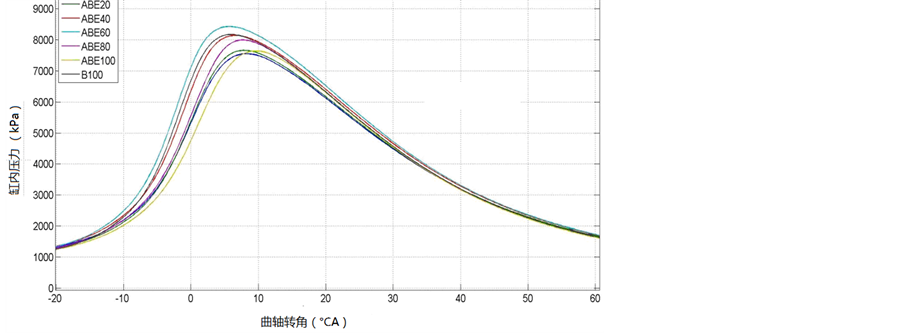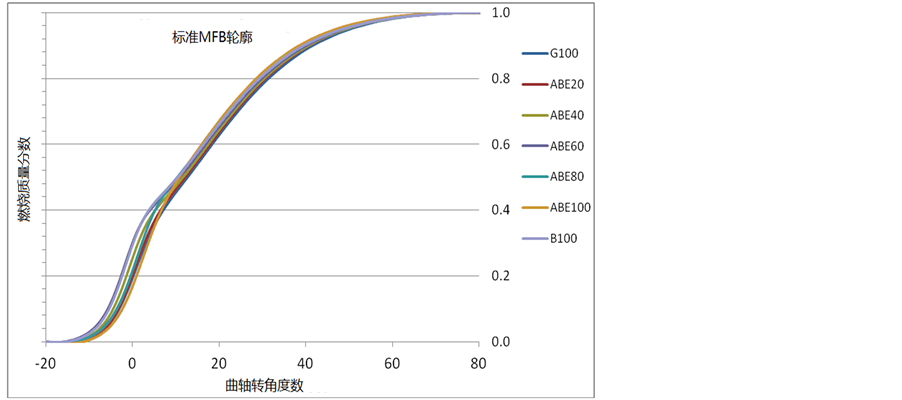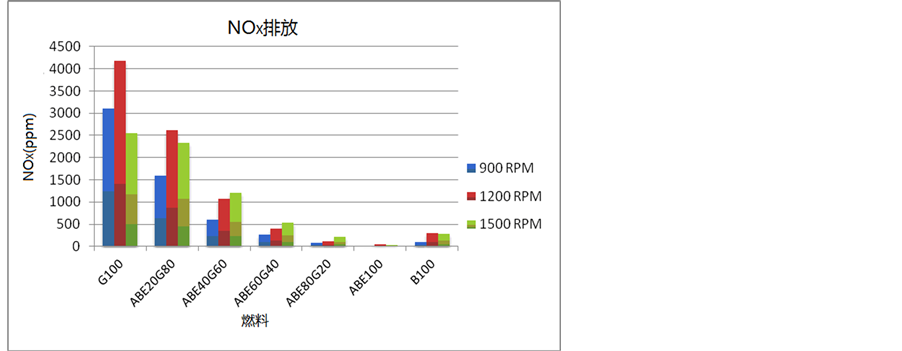1. 引言
近年来,公众对汽油、柴油和其他化石燃料的经济性和环境可持续发展性的持续关注,推动了人们对含氧燃料的研究[1] 。常用含氧化合物包括丁醇,乙醇,甲醇,甲基或乙基酯或醚。由于它们具有容易获得,成本低,氧含量高,用于现代发动机无需改良等特性,生物乙醇已经占据了美国和巴西20%~30%的燃料市场。然而,随着乙醇使用的增多,人们逐渐意识到乙醇的一些缺点,比如,在较低温度下低相位富含乙醇时,易导致发动机停转等[2] 。因为丁醇的性能与汽油更接近,因此,许多代用燃料的研究转向丁醇的使用。与汽油十分接近的空燃比,使得丁醇可以和汽油更大比例的混合,能量密度比乙醇高30%。而且,正丁醇的使用节省39%~56%的化石原料,同时,在一个生命循环周期内可以减少48%的温室气体排放。妨碍丁醇在发动机内使用的主要问题是它相对高昂的价格,很多研究机构就此进行了很多相关研究[3] -[10] 。
ABE (丙酮-丁醇-乙醇,Acetone-Butanol-Ethanol,ABE)主要是由供给的生物质原料经细菌发酵形成的,其中丙酮,丁醇和乙醇的含量分别占体积含量的22%~33%,62%~74%,和1%~6%,比例大致为3:6:1。由于石油价格的上升和化石燃料来源的减少,人们对生产生物丁醇的ABE发酵法的研究兴趣日益提升。这篇文章的目的就是探究ABE在火花点燃发动机里的燃烧特性,试图证实它作为内燃机替代燃料的潜力。
人们进行了很多在传统内燃机中应用丁醇,乙醇和其它含氧燃料的研究。Alasfour [5] [6] 研究了单缸发动机使用丁醇/汽油的混合燃料,其中丁醇占体积的30%。结果表明在相同的空燃比期间,发动机热效率有所下降,但NOx排放比使用纯汽油要低些。Dernotte等 [7] 评估丁醇汽油混合燃料在进气道喷射火花点燃发动机里的燃烧和排放特性。主要结果表明,丁醇40%/汽油60%混合燃料HC排放最小,氮氧化物排放无显著变化。Wallner等[8] 研究了纯汽油、10%乙醇(E10)和10%丁醇(Bu10)混合燃料在缸内直喷(DI)四缸火花点燃发动机的最大扭矩220 Nm条件下的燃烧性能和排放情况。结果表明,Bu10的燃烧速度高于E10和汽油。他们的进一步研究[10] 中发现,添加醇类的混合燃料无论何种工况,NOx排放都有所下降。
最近,ABE方面的研究包括ABE-柴油混合燃料在柴油机中燃烧[9] 和ABE燃烧实验和动力学建模[10] ,迄今为止,ABE在汽油机中的应用没有涉及。这就是本研究的主要目的。
2. 测试用燃料的特性
首先,按照ABE发酵产品的组成将丙酮(Acetone,纯度99.5%),丁醇(Butanol,纯度99.5%)和乙醇(Ethanol,纯度99.8%)以体积比为3:6:1进行混合成ABE燃料。然后,将ABE燃料与基础汽油一起均匀混合。ABE在汽油中所占的体积分数为20%时,简称为ABE20;以此类推。纯汽油简称为G100,纯丁醇简称为B100,纯ABE简称为ABE100。表1是各种燃料的物理化学性质。表2为混合燃料的特性。
3. 试验装置与测试方法
试验在一台单缸四冲程汽油机上进行,采用双顶置凸轮轴,每缸4气门与中间安装一个火花塞。发动机连接到一台GE型TLC-15级4-35-1700的测功机上。缸内压力用Kistler型6125 b压力传感器和一个AVL 3057-A01电荷放大器测量,曲轴位置信号由BEI XH25D轴编码器输出。实验原理图如图1所示。

Table 1. The chemical and physical properties of the fuel [8] [10]
表1. 燃料的物理化学性质[8] [10]

Table 2. The characteristics of the mixed fuel tested
表2. 测试的混合燃料的特性
表3是发动机的主要技术参数。发动机由Megasquirt II V3.0 ECU控制。这种控制根据容积效率表调整燃料的供给量,根据发动机转速(RPM)和发动机载荷(歧管压力,MAP)调整点火正时(点火提前角)。喷油器使用的是博世喷油器,在喷油压力为3 bar时,其额定喷油量为440每分钟立方厘米。
NOx和λ由装在发动机的排气歧管上Horiba MEXA-720氮氧化物的非采样型仪表测量。未燃烧的碳氢化合物和一氧化碳用Horida MEXA-554JU采样型仪表测量。探针装在发动机的排气歧管上,使得采样管能将废气传到仪表。
在这项研究中,首先燃用纯汽油,将发动机负荷固定在70 KPa。点火正时设定在20˚BTDC,有效转矩、λ和NOx平均每60秒测一次,而未燃的碳氢化合物、一氧化碳、二氧化碳和排放气体的温度直接由排放分析仪记录。此外,所有燃料的缸内压力曲线表明其缸压峰值的差异。
使用基准汽油时,测量其转矩值,对于其他燃油,调整负载的变化使得其获得与纯汽油下的一致转矩。这些测试是在三个不同的发动机速度下进行的(900,1200和1500 RPM)。测试的情况列于表4。
4. 试验结果与分析
图2~图8展示的是实验条件下对燃油性能和排放的测量结果。

Table 3. Main technical parameters of engine
表3. 发动机主要技术参数
缸内压力曲线
图2(a)显示的是所有被测燃油在转速为1200 RPM时的压力曲线。这些曲线所示的是在60秒内记录的发动机连续循环的几个25样本的平均曲线。图2(b)显示的是不同燃油压力峰值的位置。
表4. 测试条件
 (a)
(a) (b)
(b)
Figure 2. (a) Different fuel pressure curve at 1200 RPM; (b) The position of peak pressure
图2. (a) 在1200 RPM时不同燃油的压力曲线;(b) 压力峰值位置
可以看到,缸内压力峰值随着ABE含量的增加而增大,到ABE60后开始缓慢下降。当ABE的体积分数低于50%时,汽油为燃料的主要成分,由于汽油的汽化潜热较低,这将导致更快的蒸发,燃烧峰值增大。当ABE的体积分数高于50%时,ABE为燃料的主要成分,由于汽化潜热过高,这会引起燃烧峰值减低。
表面热释放率可以通过压力曲线变化计算出来,用到热力学第一定律中的公式(1)。
 (1)
(1)
其中,γ——比热容比;p——缸内压力;V——气缸容积; ——热释放量。
——热释放量。
从图3可以得出,燃烧质量分数与曲轴转角的关系。燃烧持续期缓慢增加,到ABE体积分数为60%
时下降,并且出现在更早的位置。从表2中分析知道,丙酮、丁醇、乙醇的层流火焰速度比汽油的高,需要对ABE较短的点火延迟进行调整。
有效燃油消耗率(BSFC)
如图4所示的是不同燃料在三种转速下测得的有效燃油消耗率。
可以看到,BSFC稳步增加。在1200 RPM时,最小有效燃油消耗率汽油最低,为351 g/kWh,与其相对的,ABE100为501 g/kWh,B100为466 g/kWh。与汽油相比,ABE100的油耗增加约为35%,B100的约为26%。这些差异是低容积能量密度(见表3)的混合以及由于ABE混合燃料燃烧相位的不合适,造成燃料转换效率的减少所形成的。
排放数据(UHC、CO和 )
)
在不同转速下,UHC、CO和 的排放量分别如图5、图6和图7所示。
的排放量分别如图5、图6和图7所示。
随着ABE含量的增加,UHC的排放量稳步增加。在1200 RPM时,纯汽油的UHC排放量约为200 ppm,纯ABE的UHC排放量接近960 ppm。和ABE100的未燃碳氢化合物排放量相比,ABE20到ABE80都很低。这表明,含有少量汽油可以显著提高燃烧质量。
氮氧化物
不同燃料的NOx排放测试结果如图8所示。

Figure 3. Combustion quality score distribution for different fuel in 70 kpa, 1200 RPM (20˚BTDC)
图3. 不同燃油在70 kPa,1200 RPM (点火正时20˚BTDC)时的燃烧质量分数分布图

Figure 4. Different fuel effective specific fuel consumption (BSFC)
图4. 不同燃料的有效燃油消耗率(BSFC)

Figure 5. Different fuel unexploded hydrocarbon emissions
图5. 不同燃料的未燃碳氢化合物排放

Figure 6. Carbon monoxide emissions of different fuels
图6. 不同燃料的一氧化碳排放

Figure 7. Different fuel CO2 emissions
图7. 不同燃料的CO2排放

Figure 8. Different fuel NOx emissions
图8. 不同燃料的NOx排放
NOx大幅度减少,仅体积分数为20%的ABE就减少了近40%的氮氧化物。纯ABE的NOx排放量几乎为零,相对于汽油减少近99%的NOx,相对于纯丁醇减少了80%。这是由于汽化潜热高、热值较低的乙醇和丁醇引起的,降低了缸内温度。
5. 结论
1) 缸内压力数据表明,相对汽油机而言,在ABE体积占60%以前,最高爆发压力会提前和升高,然后降低和延迟。这是由于汽油的气化潜热较低,ABE的层流火焰速度较高导致。ABE混合物的50% MFB位置比汽油机要提前,纯ABE的燃烧持续期比纯汽油要短。
2) 由于混合物中低能量成分的含量增多,平均燃油消耗率BSFC会随ABE成分的增加而增加。
3) 排放数据显示:UHC和CO稳定增加,而CO2随ABE增加而持续减少,表明燃烧不完全,这是不恰当的燃烧相位造成的。纯ABE相对汽油而言,可以减少99% NOx的排放,因为高汽化潜热导致低的绝热火焰温度。
综上所述,纯ABE燃料可以在火花点燃式发动机中燃烧,NOx的排放极大降低。随着ABE燃烧相位最优化研究的深入,其主要缺点可能克服,因而得到汽油和ABE间的最佳混合比。